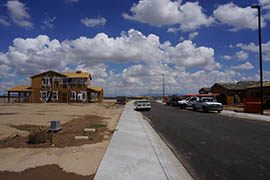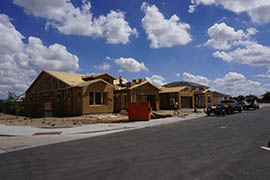Cronkite News has moved to a new home at cronkitenews.azpbs.org. Use this site to search archives from 2011 to May 2015. You can search the new site for current stories.
New-home construction lags recovery in economy, real estate
PHOENIX – Home prices are on the rise in the Valley, but new single-family homes aren’t very plentiful because of the time it takes homebuilders to get land ready for construction.
The region currently has 208 subdivisions with more than 10 available plots, according to CRA, a Scottsdale-based real estate brokerage firm. By comparison, the area had 710 similar subdivisions in 2007.
CRA’s research focused on the average homebuilder “churning and burning” through inventory and excluded age-restricted communities, condominiums and homes built entirely to customers’ preferences, said Todd Vesledahl, vice president of sales.
“It’s really, really interesting to watch how this market’s going to unfold,” Vesledahl said.
The low inventory reflects the new home industry’s pessimism of a few years ago, said Michael Orr, director of the Real Estate Center at Arizona State University’s W.P. Carey School of Business.
From the purchase of the land to the construction of a house, Phoenix homebuilders face an 18-month lag because of issues like permits and impact fees, Orr said.
The housing market is moving back to normal, Orr said. Other outliers, like high levels of investors and Canadians in the market, are also trending back to regular levels, he said.
“I think that most of what you’re seeing is gradually getting a little bit more back to normal,” Orr said, “but the one thing that takes the longest to go back to normal is the supply of new homes.”
Phoenix has a small amount of available new homes, but homebuilders are also hesitant to get caught with surplus inventory if the market were to collapse, said Ken Peterson, vice president of sales at Shea Homes.
“We’re just being more strategic,” he said.
The Phoenix area is still attractive to homebuilders, Peterson said.
“It’s not like we’re scared,” he said. “We’re very confident in the market.”
Orr said that the lack of new homes is a national issue.
About 1.5 million homes were built annually since World War II; however, the new home market has experienced a deficit in recent years, he said.
The country will eventually experience an above-average number of new homes in the market, Orr said.
“My feeling is that eventually we’ll go back to building more than 1.5 million units in order to compensate for that deficit,” he said. “Nobody knows quite how fast it’ll happen though.”
The new home industry should target about 500 active subdivisions, Vesledahl said. That goal could be reached in three to five years if interest rates remain low and no global crises emerge, he said.
Vesledahl said that 157 new subdivisions will enter the marketplace in a year; however, 83 current developments will fall out of CRA’s research parameters if each one make three sales a month.
At that rate, the area will have 282 subdivisions in a year, a number that is still low, Vesledahl said.








